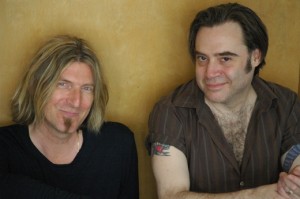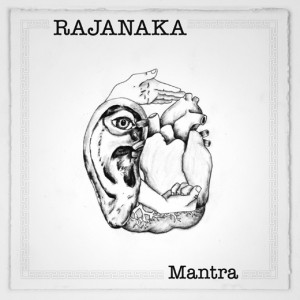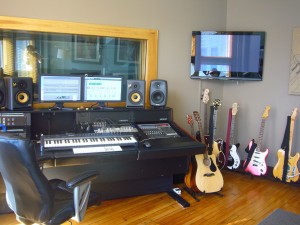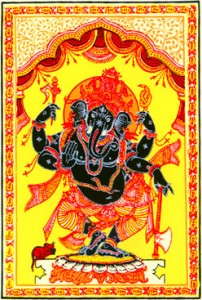Brad Roberts of Crash Test Dummies: Music, Mantras, Recording & Rituals
FLATIRON DISTRICT, MANHATTAN: If you’ve lived in New York City long enough, hopefully you’ve experienced this distinctive pleasure: walking around a blind corner only to encounter the face of a long-lost friend. At these moments, the massive metropolis magically shrinks down to a small town.
If that early acquaintance just happens to be a 10x-platinum selling rock star, all the more exhilarating, right? Well, that was exactly what happened to Terry Derkach in 2010, a multitasking NYC-based producer/engineer/songwriter two decades removed from his native Winnipeg. On a fateful afternoon stroll through Greenwich Village one day, his path led him directly to his old pal Brad Roberts, widely known as one of the most distinctive voices in modern music via his equally distinctive band, Crash Test Dummies.
Turns out, Roberts had taken his own circuitous route out of the picturesque capital of Manitoba in Canada, settling happily in Harlem to continue his artistic pursuits. Former bandmates in Winnipeg (also the hometown of musical luminaries Neil Young and The Guess Who), the reunited friends were soon collaborating again – on a project of Tantric proportions that neither of them could ever have imagined.
Mmm Mmm Om Mmm
Once he settled in NYC, Derkach had been hard at work building up VRTCL Entertainment, a diverse audio practice that now hums busily with composing, sound design, and original music projects from a sun-kissed studio in the Flatiron District.
100 blocks or so uptown, Roberts had been doing some multitasking of his own. Crash Test Dummies were continuing to record and tour, playing to a dedicated fan base, many of whom had first embraced them with their 1993 international smash “Mmm Mmm Mmm Mmm”, then stayed connected to the band for its nine-album career.
Crash Test Dummies’ discography is still in progress, the most recent release being 2010’s Oooh La La!. Meanwhile, Roberts has been nurturing his instantly recognizable bass-baritone voice – and the rest of his body and soul – with a steady regimen of Asana yoga. Along with the repertoire of Asana postures, Roberts became simultaneously engrossed in a Tantric lineage called the Rajanaka, which originally flourished in the 9th Century and was brought back to the West by the scholar and practitioner Dr. Douglas Brooks.
Central to Rajanaka, a study of yoga traditions and the cultures of Sanskrit and Tamil literatures, is the reciting of mantras – succinctly defined as a sound, syllable, word, or group of words that is considered capable of creating transformation. “Om” is only the start of the myriad mantras that have emerged over the millennia, and they can serve as extraordinarily powerful tools for those who incorporate them into their lives.
Picture the sonically sound logic of Brad Roberts murmuring “Om” into a microphone, and the next step reveals itself: he must record these spiritually satisfying sonics.
Reimagining the Mantra
The result is the recently released album Rajanaka: Mantra, whose seven engrossing tracks are the first of a series that Roberts will issue. “As soon as I saw what was behind the meditation and ritual of mantras, I heard a musical equivalent in my head,” says Roberts, whose speaking voice contains just a hint of the powerful growl in his recordings. “It became apparent very quickly that they’re just as usable as I’d imagined they’d be.”
Determined to produce anything but a New Age record, Roberts and Derkach began creating original song structures around the ancient Rajanaka utterings, invoking influences ranging from Sigur Ros to Massive Attack as their arrangements unfolded.
Collaborating at VRTCL they calculated the odd time signatures dictated by the mantras, then used everything from futuristic soft synths to massive drums to underscore Roberts’ incomparable vocal tracks, as the singer recorded hypnotic textures that could go up to 30 overdubs deep.
The album’s opener “Shiva Bija” provides a sparsely beautiful entre to this pioneering genre. It’s the perfect setup to “Om Namo Ganapataye”, whose percussive elements and ominously fluttering pads help Roberts to invoke the presence of Ganapti, a Tantric deity capable of sorting the world’s rabble into manageable forms. Later, on in “The Wonderful Destroyer”, a 7/4 framework supports layers of hair-raising sound design, huge drums, and an ever-growing collage of Roberts honoring the three forms of the Lord of Yoga, Shiva, with the repetition of an involved mantra – all of it as meditative as it is powerfully moving, intoning:
Om hrim pashupataye vau shat
Om klim bhairavaya swa hah
Om srom dakshanamurtaye namah-hah
In the Studio
Beyond the shared history between Derkach and Roberts, another very good reason emerged for their collaboration on Rajanaka. “It turned out, oddly, that he’s extremely well-qualified for the job,” Roberts says of Derkach, “in that he listens to a lot of ambient music, a lot of tribal music, plus a lot of outside stuff. And, of course, this album is pretty outside.”
Working together with Roberts for the first time in decades, Derkach was reintroduced not just to the singer’s distinctive voice, but also to his sharp ears for creating arrangements. Roberts would record mantra chants at VRTCL, after which Derkach would add guitar, piano, pads and percussion, then email MP3’s to Roberts uptown for feedback. When the song had taken shape, Roberts would return to VRTCL to record the vocals again plus all necessary overdubs.
But getting ancient mantras, meant to be uttered purely a cappela – alone or in groups – to snap neatly into song structures relatable to modern ears required a sonic sleight of hand. Check out track seven, “Invocation”, where the pair deftly make beautiful music out of “lyrics” that repeat, “Om Namah Shivaya Gurave/ Satchidananda Murtaye/ Nishprapanchaya Shantaya/ Niralambaya Tejase” and you get a grasp of the subtle puzzle at hand.
“What’s hard is getting the mantras to fit into a time signature that feels comfortable,” explains Roberts. “There were 15-syllable mantras, which are completely inconvenient. We’d build a time signature around the mantra, and nothing ever came out as 4/4 time – we had to invent rhythms the likes of we which he had not heard. Terry did most of that: He’d invent the sonic version of the mantra’s essence.”
Not surprisingly, stock loops were out of the question for Rajanaka: Mantra. Instead, Derkach turned frequently to Spectrasonics’ Omnisphere, Native Instruments’ Battery, and FabFilter to make the record’s transporting arrangements.
“A lot of it was done in Battery, where you’re able to take a tone, start working with the various ADSR filters, and then start constructing a sound that’s the essence of something dark,” says Derkach. “Maybe that’s used to start along with the mantra and set the tone of the piece. Then certain other things would be added – for a part of the mantra that’s light and shimmering, we’d go to some high-end crystalline synth sounds, bells, or chimes.”
In the mix phase, Derkach would use Beatles-inspired techniques such as extreme panning when appropriate. “On a song like ‘The Wonderful Destroyer,’ the drums are only on the right, but they sound massive,” he notes. “Once we put them there, it left all this room on the left for Brad, doing the mantra super-low. So the drums are over there, the voice is over here, and it’s a huge sound.”
The Voice: Recording
When one of music’s most instantly recognizable voices steps into your live room, the pressure’s on to capture a terrific recording. Derkarch stepped up to the plate with a Groove Tubes large diaphragm condenser microphone, a Universal Audio 6176 mic pre, and his own hand-made mic cables. “I have a great signal path,” he says. “My gear is meant to capture the tone, not color it.”
While Roberts was clearly blessed with a natural gift, equally important is the fact that he knows exactly how to use it live and in the studio. “It’s so important to sing into the microphone correctly,” he says simply. “I see so many singers back off the mic, they sound thin, and the sound man is trying to boost it up. The whole time I’m thinking, ‘Put that thing in your mouth!’
“I like to get close to the mic for the proximity effect, which brings the bass out so I sound monstrous. I have a low voice to begin with, and that technique, along with a large diaphragm microphone, really amps it up again. If you have your mic technique down, then you can go from one extreme to another – be loud and boomy, or soft and sweet.”
Hits of a Different Kind
Untold legions of songwriters enter the music arena, but only a tiny fraction taste the level of success that Roberts has achieved. The attention-grabbing “Superman’s Song” off the Crash Test Dummies’ 1991 album The Ghosts That Haunt Me was his first invitation into the hit circle, while “Mmmm Mmmm Mmmm Mmmm” was a certifiable world smash that launched the Dummies’ 1993 album God Shuffled His Feet – and the band itself – into even more rarefied territory.
From those celebrated experiences, and the ongoing journey that’s enabled him to continue releasing records with Crash Test Dummies, Roberts has gleaned the unique lessons that come from bringing hit songs into the world.
“I learned that a lot of people use music in a huge variety of ways,” he reflects. “I had no idea that people were so affected by the writing that I had done, and I don’t think that I appreciated at the time what was really going on. Because when you sell ten million records, how are you supposed to fathom what sort of memories you’re making in these other people?
“I write these songs, and people create meaning for them. The lyrics might be there and very personal to me, but they’ll relate them to certain meanings in their life. I found out that there really is interplay between listener and song. Once a song gets out on that scale, it’s not really mine anyhow. Everybody has an idea about it – I just made it up.”
With Rajanaka: Mantra, then, its fitting that Brad Roberts and Terry Derkach – following a cosmically random convergence — embraced what could be arguably called the greatest hits ever written. Developed, shared, internalized, and depended on by countless generations, mantras span eons and language with their universal utility. This isn’t the first time these truly timeless communications have been set to music, but it’s safe to say they’ve never sounded like this before.
“I can’t think of what genre I would put this record in, if I tried,” Roberts says. “It’s very complex — every time you listen, you hear something new in it. This is like nothing I’ve ever done, like nothing I’ve ever heard, and represents challenges that I have never faced.”
— David Weiss
Special thanks to TuneFund for helping to make this article happen.
Please note: When you buy products through links on this page, we may earn an affiliate commission.











Patrick Ross
April 17, 2012 at 5:53 pm (13 years ago)WOW WOW WOW !!! Congratulations Brad and Terry, Terry and Brad !!! Looking forward to enjoying this landmark creation !!!
Patrick and Susan Ross
Patrick Ross
April 17, 2012 at 6:28 pm (13 years ago)Just listened to The Wonderful Destroyer … it is a MASTERFUL journey !
Leni
August 2, 2012 at 1:45 pm (13 years ago)Brad, you are more awesome today than years past. Simply one with the music and you are having fun. We should all be so blessed.